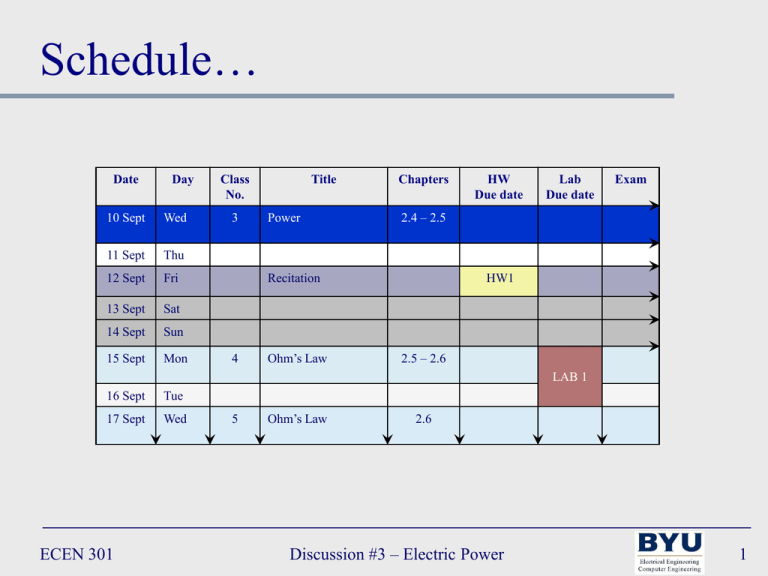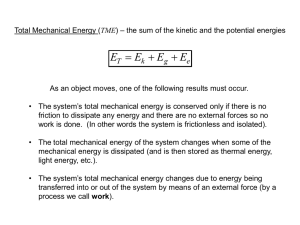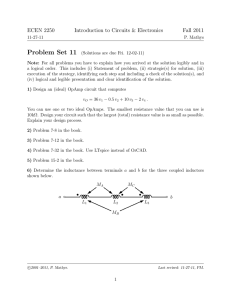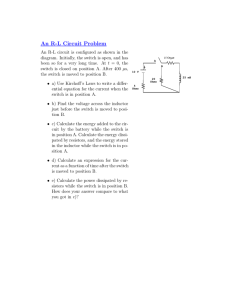Discussion #2 - Electric Power
advertisement

Schedule… Date Day 10 Sept Wed 11 Sept Thu 12 Sept Fri 13 Sept Sat 14 Sept Sun 15 Sept Mon Class No. 3 Title Power Chapters Ohm’s Law Lab Due date Exam 2.4 – 2.5 Recitation 4 HW Due date HW1 2.5 – 2.6 LAB 1 16 Sept Tue 17 Sept Wed ECEN 301 5 Ohm’s Law 2.6 Discussion #3 – Electric Power 1 True Power – The Book of Mormon Alma 37:14, 16, 18 14 And now remember, my son, that God has entrusted you with these things, which are sacred, which he has kept sacred, and also which he will keep and preserve for a wise purpose in him, that he may show forth his power unto future generations. 16 But if ye keep the commandments of God, and do with these things which are sacred according to that which the Lord doth command you, (for you must appeal unto the Lord for all things whatsoever ye must do with them) behold, no power of earth or hell can take them from you, for God is powerful to the fulfilling of all his words. 18 For he promised unto them that he would preserve these things for a wise purpose in him, that he might show forth his power unto future generations. Mormon 8:15, 16, 22, 26, 28 15 For none can have power to bring it to light save it be given him of God; for God wills that it shall be done with an eye single to his glory, or the welfare of the ancient and long dispersed covenant people of the Lord. 16 And blessed be he that shall bring this thing to light; for it shall be brought out of darkness unto light, according to the word of God; yea, it shall be brought out of the earth, and it shall shine forth out of darkness, and come unto the knowledge of the people; and it shall be done by the power of God. 22 For the eternal purposes of the Lord shall roll on, until all his promises shall be fulfilled. 26 And no one need say they shall not come, for they surely shall, for the Lord hath spoken it; for out of the earth shall they come, by the hand of the Lord, and none can stay it; and it shall come in a day when it shall be said that miracles are done away; and it shall come even as if one should speak from the dead. 28 Yea, it shall come in a day when the power of God shall be denied… ECEN 301 Discussion #3 – Electric Power 2 Lecture 3 – Electric Power ECEN 301 Discussion #3 – Electric Power 3 Energy vs. Power Consider filling a pool of water The rate (power) at which the water comes out determines how long it will take to fill the pool The water that has filled the pool represents energy Both pools have the same amount of water (energy) – the rate at which they were filled (power) was different 20 minutes ECEN 301 Discussion #3 – Electric Power 10 minutes 4 Energy vs. Power Power: the rate at which energy (electricity) is consumed How fast energy can be generated/delivered to/from an electrical device Energy: the ability to do work EX: a battery, a capacitor, a fuel cell Energy Power Duration of Use joule (J): electric energy unit. 1 J = the work required to move an electrical charge of 1C through 1V 1 J = the energy required to lift a small apple (102 g) one meter against Earth's gravity. 1 J = the energy required to heat one gram of dry, cool air by 1 degree Celsius. 1 J = 6.241506363091018 eV (electron-volts) 1 J = 2.7778 x10-7 kilowatt-hour kilowatt-hour (kWh): electric energy unit. ECEN 301 Discussion #3 – Electric Power 5 Electric Power Electric Power: the power generated by an active element, or dissipated by a passive element is equal to the product of: voltage across the element and current flowing through it P i v Watt (W): electric power unit. 1 Watt = 1 joule/second (J/s) 1 Watt = 1 volt-amp (VA) ECEN 301 Discussion #3 – Electric Power 6 Electric Power Passive sign convention: power dissipated by a load is a positive quantity – the power generated by a source is positive i i a + _ b vab ECEN 301 b _ vba Passive Element (load) • power dissipated = vi • power generated = -vi Positive voltage a + Active Element (source) • power dissipated = -vi • power generated = vi Negative voltage Discussion #3 – Electric Power 7 Passive Sign Convention 1. Choose an arbitrary direction for current flow 2. Label polarities of all active elements (sources) based on direction of current flow 3. Label polarities of all passive elements (loads) based on direction of current flow 4. Compute the power dissipated by each element based on: a) If current flows into the positive terminal of the element, the power dissipated is positive (power is absorbed) b) If current flows into the negative terminal of the element the power dissipated is negative (power is delivered) ECEN 301 Discussion #3 – Electric Power 8 Electric Power Example1: find the power dissipated by each element. va = 8V, vb = 4V, i = 0.1A Load A ECEN 301 Load B Vs Discussion #3 – Electric Power 9 Electric Power Example1: find the power dissipated by each element. va = 8V, vb = 4V, i = 0.1A 1. Load A i ECEN 301 Load B Vs Assume a clockwise direction of current flow Discussion #3 – Electric Power 10 Electric Power Example1: find the power dissipated by each element. va = 8V, vb = 4V, i = 0.1A 1. 2. Load A Vs _ ECEN 301 i Load B + Assume a clockwise direction of current flow Label polarity of sources according to current flow Discussion #3 – Electric Power 11 Electric Power Example1: find the power dissipated by each element. va = 8V, vb = 4V, i = 0.1A + va – 1. 2. Load A Vs _ ECEN 301 i + vb – Load B + 3. Assume a clockwise direction of current flow Label polarity of sources according to current flow Label polarity of loads according to current flow Discussion #3 – Electric Power 12 Electric Power Example1: find the power dissipated by each element. va = 8V, vb = 4V, i = 0.1A + va – 1. 2. Load A Vs _ i + vb – Load B + 3. 4. ECEN 301 Assume a clockwise direction of current flow Label polarity of sources according to current flow Label polarity of loads according to current flow Calculate power dissipated in each element Discussion #3 – Electric Power 13 Electric Power Example1: find the power dissipated by each element. va = 8V, vb = 4V, i = 0.1A + va – 1. 2. Load A Vs i _ + vb – Load B + 3. 4. Assume a clockwise direction of current flow Label polarity of sources according to current flow Label polarity of loads according to current flow Calculate power dissipated in each element Using KVL : vs va vb vs 0 va vb 8 4 12V ECEN 301 Discussion #3 – Electric Power 14 Electric Power Example1: find the power dissipated by each element. va = 8V, vb = 4V, i = 0.1A + va – 1. 2. Load A Vs i _ Load B + vb – + 3. 4. Using KVL : vs va vb vs Ps 0 va vb Assume a clockwise direction of current flow Label polarity of sources according to current flow Label polarity of loads according to current flow Calculate power dissipated in each element vs i ( 12V ) (0.1A) 1.2W Pa va i (8V ) (0.1A) 0.8W Pb vb i (4V ) (0.1A) 0.4W 8 4 12V ECEN 301 Discussion #3 – Electric Power 15 Electric Power Example1: find the power dissipated by each element. va = 8V, vb = 4V, i = 0.1A – va + 1. Load A Vs + i Load B – vb + – va vb vs 3. 4. Using KVL : vs 2. 0 va vb 8 4 Ps Assume a counter-clockwise direction of current flow Label polarity of sources according to current flow Label polarity of loads according to current flow Calculate power dissipated in each element vs i ( 12V ) (0.1A) 1.2W Pa va i (8V ) (0.1A) 0.8W Pb vb i (4V ) (0.1A) 0.4W 12V ECEN 301 Discussion #3 – Electric Power 16 Electric Power Example1: find the power dissipated by each element. va = 8V, vb = 4V, i = 0.1A – va + Load A Vs + i Load B – vb + – NB: Power is conserved (power supplied always equals power consumed): Ps + P a + Pb = 0 Using KVL : vs va vb vs 0 va vb 8 4 Ps vs i ( 12V ) (0.1A) 1.2W Pa va i (8V ) (0.1A) 0.8W Pb vb i (4V ) (0.1A) 0.4W 12V ECEN 301 Discussion #3 – Electric Power 17 Electric Power Example2: find the power dissipated by each element. – 3V + ie = 2A B + E 10V – D A id =3A C – 5V + ECEN 301 Discussion #3 – Electric Power 18 Electric Power Example2: find the power dissipated by each element. – 3V + a ie = 2A B ia + E 10V – D A KCL at node a : ia id id =3A ie 0 ia id ie 3 2 5A C – 5V + ECEN 301 Discussion #3 – Electric Power 19 Electric Power Example2: find the power dissipated by each element. – 3V + ie = 2A KVL at Loop1 : B ia = 5A + va A – + E 10V – D Loop1 va vb ve vc id =3A va 0 ve vc vb 10 5 3 12V C – 5V + ECEN 301 Discussion #3 – Electric Power 20 Electric Power Example2: find the power dissipated by each element. – 3V + ie = 2A KVL at Loop2 : B ia = 5A + 12V A – Loop2 + D vd – + E 10V – va vb vd vc 0 vd va id =3A vb vc 12 3 5 10V C – 5V + NB: since load D and load E share the same node their voltages will be the same ECEN 301 Discussion #3 – Electric Power 21 Electric Power Example2: find the power dissipated by each element. – 3V + Pa ie = 2A B ia = 5A + D 10V – + 12V A – + E 10V – 12V 5 A Pc 60W A s upplies 60W 25W C a bsorbs 25W Pb Pd 3V 5 A 10V 3 A 30W D a bsorbs 30W 15W B s upplies 15W id =3A Pe 10V 2 A 20W E a bsorbs 20W C – 5V + Total Pow er Supplied : Pa Pb 60W 15W Total Pow er Absorbed : Pc Pd Pe 75W ECEN 301 5V 5 A Discussion #3 – Electric Power 25W 30W 20W 75W 22 Electric Power Example3: The battery supplies a total of 10mW. What is i3? i1 = 1mA, i2 = 1.5mA i i1 4V i2 i3 + _ i ECEN 301 Discussion #3 – Electric Power 23 Electric Power Example3: The battery supplies a total of 10mW. What is i3? i1 = 1mA, i2 = 1.5mA Ps i i 4V i1 + _ + _ i i2 i3 + + _ _ i v Ps v 10 mW 4V 0.01W 4V 0.0025 A Using KCL : i i1 i2 i3 i3 0 i i1 i2 2.5 2 1.5 1.0mA 2.5mA ECEN 301 Discussion #3 – Electric Power 24 i–v Element Characteristics The relationship between current (i) and voltage (v) at the terminals of a circuit element defines the behaviour of that element within the circuit + v _ ECEN 301 i • If a voltage is imposed across the terminals of the element the voltage itself (v) and the current that will flow (i) form a unique pair of values. • measuring the current while the voltage varies is known as the i–v characteristic • with the i–v characteristic voltage (current) can be determined from a given current (voltage) • power can also be determined Discussion #3 – Electric Power 25 i–v Element Characteristics i–v characteristic can be given as: a function i v f (v) g (i ) a graph i (amps) 0.3 0.2 0.1 0 -60 -40 -20 0 20 40 60 v (volts) -0.1 -0.2 -0.3 ECEN 301 Discussion #3 – Electric Power 26 i–v Element Characteristics Power generated vs. power dissipated quadrants 0.3 Generated (sources) i (amps) Dissipated (loads) 0.2 0.1 v (volts) 0 -60 -40 -20 Dissipated (loads) 0 -0.1 -0.2 20 40 60 Generated (sources) -0.3 ECEN 301 Discussion #3 – Electric Power 27 i–v Element Characteristics Elements that source and dissipate power Photovoltaic – solar cells, photodiodes, photodetectors 4 2 x 10 1.5 1 Dissipate 0.5 0 -0.5 -1 Dissipate Generate -1.5 -2 -10 ECEN 301 -8 -6 -4 -2 0 2 4 6 Discussion #3 – Electric Power 8 10 28 i–v Element Characteristics Ideal DC current source 3A source Ideal DC voltage source 6V source i 8 7 6 5 4 3 2 1 8 7 6 5 4 3 2 1 0 0 i 8 7 6 v ECEN 301 + _ Vs Is 5 4 3 2 1 8 7 6 5 4 3 2 1 0 0 v Discussion #3 – Electric Power 29






